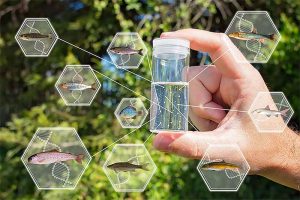e-DNA:

According to some studies, DNA floating in the air (i.e. e-DNA) can boost biodiversity conservation efforts across the world.
- Researchers from two teams have independently shown that environmental DNA (e-DNA) can potentially identify and monitor terrestrial animals.
- Animals shed DNA through their breath, saliva, fur or faeces into the environment and these samples are called e-DNA.
- Airborne e-DNA sampling is a biomonitoring method that is rising in popularity among biologists and conservationists as it provides abundant information.
- It can help understand the composition of animal communities and detect the spread of non-native species.
- This method will work with the current techniques to monitor endangered species after some fine-tuning.
- Typically, biologists observe animals in person or by picking up DNA from animals’ footprints or faeces, which demand extensive fieldwork.
- Spotting animals can be challenging, especially if they inhabit inaccessible habitats.
- It can aid in tracking long-distance migratory birds and other birds’ flying patterns. It can also capture DNA from smaller animals including insects.
- Last year (2021), a proof-of-concept study used airborne e-DNA to monitor terrestrial insects.
- As wildlife ecosystems become rapidly and extremely chaotic owing to the alarming effects of climate change, terrestrial biomonitoring techniques are expected to adapt and progress rapidly for accurate and timely monitoring.
e-DNA:
- Environmental DNA (e-DNA) is nuclear or mitochondrial DNA that is released from an organism into the environment.
- Sources of eDNA include secreted feces, mucous, and gametes; shed skin and hair; and carcasses. eDNA can be detected in cellular or extracellular (dissolved DNA) form.
- In aquatic environments, eDNA is diluted and distributed by currents and other hydrological processes, but it only lasts about 7–21 days, depending on environmental conditions.
- Exposure to UVB radiation, acidity, heat, and endo- and exonucleases can degrade e-DNA.




